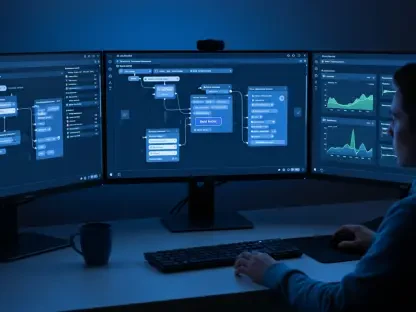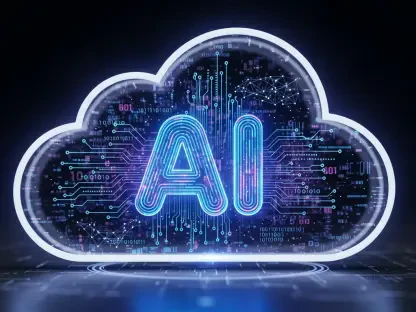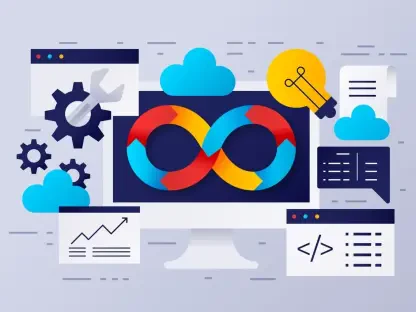In an era marked by rapid technological advancement and digital transformation, organizations are increasingly integrating security measures at every stage of software development, leading to the rise of DevSecOps. Central to this shift is threat modeling, which has become essential as businesses proactively address cybersecurity risks. As companies focus on delivering robust software while maintaining rigorous security standards, the significance of threat modeling within DevSecOps grows unmistakably pivotal. This process enables developers to identify and manage potential threats early in the software development lifecycle, aligning security practices with the swift pace of modern software delivery.
Market Momentum and Methodology Evolution
Understanding the DevSecOps Surge
The DevSecOps market has witnessed substantial growth with an impressive trajectory expected to reach $15.9 billion by the end of 2027, reflecting a robust annual growth rate. These numbers highlight a significant transformation in organizational strategies to secure their software deployments and integrate security seamlessly. By adopting DevSecOps practices, companies acknowledge the inadequacy of conventional security measures in today’s dynamic development environments. The numbers speak volumes: currently, 95% of software development projects harness DevSecOps methodologies, with over three-quarters of rapid development teams integrating these strategies fully. This widespread adoption reflects an essential reorientation in corporate priorities, where minimizing vulnerability rates is not just a goal but an essential operational requirement.
Advances in Threat Assessment Practices
Structured threat modeling has risen to prominence as companies seek reliable methodologies to systematically identify and manage security threats. Frameworks like Microsoft’s STRIDE have become key tools, categorizing potential threats into discrete types, such as Spoofing and Tampering. These strategies empower development teams to perform in-depth threat analyses without requiring advanced security expertise, fostering a culture of inclusivity and access in threat assessment efforts. Another notable methodology is PASTA, which offers a more comprehensive perspective by aligning business goals with technical requirements, significantly enhancing its usefulness in enterprise environments. Additionally, the DREAD model offers a practical risk assessment method, scoring threats on their damage potential and other criteria, thereby allowing organizations to prioritize security resources efficiently according to identified risks.
Integration of Tools and Collaboration
Automating Threat Modeling
Automating threat modeling has become a strategic priority as enterprises incorporate sophisticated tools into their DevSecOps frameworks. Presently, 80% of these initiatives rely on automated vulnerability scanning solutions, a significant increase from previous years. These technologies, like IriusRisk and OWASP Threat Dragon, leverage AI-driven threat libraries to improve security capabilities across platforms. By integrating with current development workflows, they ensure threat models remain aligned with adaptive application architectures, effectively synchronizing security practices with ongoing software evolution. The automation of these procedures not only enhances accuracy but also facilitates timely adjustments, ensuring the sustainability of security measures in the face of burgeoning technological complexities.
The Importance of Cross-Team Synergy
Implementing threat modeling effectively hinges on robust collaboration across development, security, and operations teams. This methodology blends smoothly with agile development processes, positioning threat modeling as an integral part of every development iteration. Such integration promotes constant improvement without hindering development speed, allowing teams to swiftly address potential security issues. During the process, organizations establish a definable scope that outlines critical assets and user data protection needs. This is followed by careful asset mapping and threat analysis, culminating in a meticulous risk prioritization strategy and mitigation plan. Embedded within agile frameworks, these efforts ensure that development speed and security integrity grow in tandem, creating a resilient and adaptable software delivery ecosystem.
Economic and Strategic Implications
Financial Benefits of Proactive Threat Management
The cost efficiencies associated with early threat identification are profound, with studies showing a substantial difference in correction costs when threats are addressed during development rather than later stages. Rectifying defects during the initial phases is exponentially cheaper compared to post-deployment fixations. This economic benefit underlines the “shift left” strategy, urging organizations to integrate threat modeling early in the development process. Real-world applications, epitomized by a case study within the energy sector, illustrate improved security postures and operational efficiencies achieved through comprehensive DevSecOps practices. These include automated threat detection and risk assessment integration, fostering a holistic approach to continuous monitoring capabilities that significantly enhance organizational security efficacy.
Preparing for Future Challenges
In today’s world, characterized by fast-paced technological progress and the ongoing digital transformation, organizations are increasingly embedding security measures throughout every phase of software development. This trend has given rise to the concept of DevSecOps. At the heart of this approach is threat modeling, which has emerged as a crucial component as companies take a proactive stance on cybersecurity risks. By focusing on delivering strong, secure software, businesses underscore the vital role threat modeling plays within DevSecOps. This process is instrumental in enabling developers to anticipate and address potential security threats early in the software development lifecycle. By doing so, it aligns security practices with the rapid pace of contemporary software delivery. With cyber threats continuously evolving, companies must remain agile and responsive to ensure their security strategies are robust. As a result, threat modeling not only helps maintain high security standards but also harmonizes with the demanding speed of modern software production.








